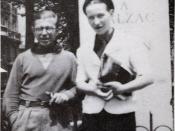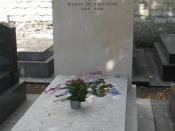In the play No Exit, Sartre examines the question of existence and essence through the actions of Garcin, Inez, and Estelle. Since they have all recently died, they must confront the existence of their consciousness as their physical bodies are buried on earth. Using each individual's consciousness and the "other" part of him/herself that observes that consciousness, Sartre creates a situation where each character must ignore or accept the judgment of the other two. For example, when they first meet, Inez says that Garcin's mouth looks grotesquely frightened. Since there are no mirrors, Garcin must decide if Inez is right or what he thinks himself is right. In this case, Garcin believes Inez rather than his own judgment. He lets her define his essence, or personal characteristics, and thus, in Sartre's definition, has "bad faith."
Sartre uses exposition to introduce his audience to each character by placing them in a strange and unusual situation.
Each character thus explains how they died and what they think of their room/hell with out sounding awkward. Sartre also foreshadows many of the major themes of the play in this first section. For example, even though they are already dead and have nothing to hide each character continues to lie to themselves. Garcin pretends to find the furniture shocking, while Estelle pretends that she is in hell by mistake. Also, Estelle's first impression that Garcin was her dead lover foreshadows their future relationship. Because the two lie to themselves, they are acting in "bad faith".
Sartre tends to emphasize the theme of self-deception throughout this play. Even though they are already dead, both Garcin and Estelle will not admit to themselves why they are in hell. They have nothing to lose by admitting the truth, but they are so in the habit of being...


